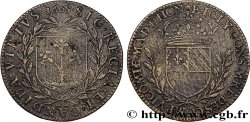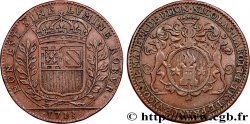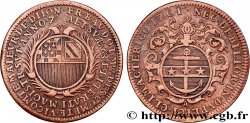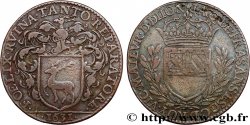fjt_459332 - DIJON (MAIRES DE ... et divers) Pour le Sénat de Dijon 1616
250.00 €
Количество
Добавить в корзину

Тип Pour le Sénat de Dijon
Дата: 1616
Монетный двор / Город: Paris
Металл: silver plated copper
Диаметр: 27 mm
Ориентация осей монеты: 6 h.
Вес: 4,92 g.
Век: lisse
Редкость: R2
Ссылки в каталоге: :
Лицевая сторона
Аверс: легенда: .(ROSETTE). SENATVS (ROSETTE) DIVI - ONENSIS (ROSETTE) 1616..
Аверс: описание: Écus accolés de France et de Navarre couronnés, entourés des colliers des Ordres de Saint-Michel et du Saint-Esprit.
Аверс: перевод: (Le Sénat de Dijon).
Обратная сторона
Реверс: легенда: (ROSETTE) SEDET. OMNIBVS. VNA (ROSETTE).
Реверс: Описание: La Justice trônant de face sous un dais fleurdelisé, tenant l'épée haute de la main droite et une balance de la gauche ; à l’exergue : .1616..
Реверс: перевод: (Elle juge de même pour tous).
Комментарий
Un autre exemplaire connu : MONNAIES IV n° 1058.
Ce jeton est par ailleurs non répertorié. Le droit de ce jeton est utilisé par les Grandes Administrations, en particulier le Conseil du Roi mais c'est la première fois que nous rencontrons ce type de droit avec cette devise.
Ce jeton semble être le seul frappé par le Sénat de la ville. La date, présente des deux cotés du jeton, ce qui est très rare, doit avoir une importance particulière. Ce jeton est peut-être à mettre en rapport avec la Réunion des États Généraux qui se sont tenus en 1614 (dernière fois avant 1789) et pendant lesquels le Sénat de Dijon aurait pu remplir un rôle ou une mission. Ce jeton semble être en argent ou en cuivre argenté..
Ce jeton est par ailleurs non répertorié. Le droit de ce jeton est utilisé par les Grandes Administrations, en particulier le Conseil du Roi mais c'est la première fois que nous rencontrons ce type de droit avec cette devise.
Ce jeton semble être le seul frappé par le Sénat de la ville. La date, présente des deux cotés du jeton, ce qui est très rare, doit avoir une importance particulière. Ce jeton est peut-être à mettre en rapport avec la Réunion des États Généraux qui se sont tenus en 1614 (dernière fois avant 1789) et pendant lesquels le Sénat de Dijon aurait pu remplir un rôle ou une mission. Ce jeton semble être en argent ou en cuivre argenté..








 Cообщить об ошибке
Cообщить об ошибке Распечатать страницу
Распечатать страницу Отправить мой выбор
Отправить мой выбор Задать вопрос
Задать вопрос Consign / sell
Consign / sell
 Информация
Информация



